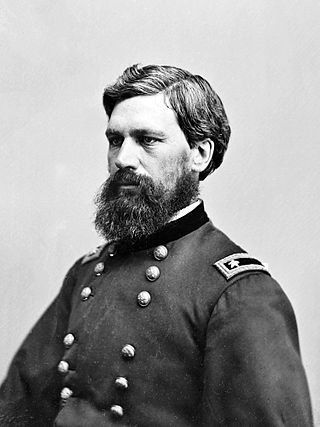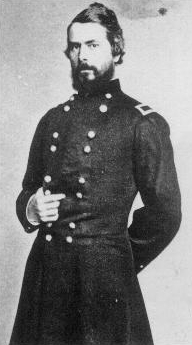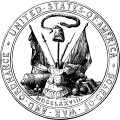Related Research Articles

The Army of Northern Virginia was the primary military force of the Confederate States of America in the Eastern Theater of the American Civil War. It was also the primary command structure of the Department of Northern Virginia. It was most often arrayed against the Union Army of the Potomac.

Oliver Otis Howard was a career United States Army officer and a Union general in the Civil War. As a brigade commander in the Army of the Potomac, Howard lost his right arm while leading his men against Confederate forces at the Battle of Fair Oaks/Seven Pines in June 1862, an action which later earned him the Medal of Honor. As a corps commander, he suffered a major defeat at Chancellorsville and his performance was of question at Gettysburg in May and July 1863. However, he recovered from possible career setbacks as a successful corps and later army commander, commanding the Army of the Tennessee from July 27, 1864 until May 19, 1865 leading the army in the battles of Ezra Church, Battle of Jonesborough, Sherman's March to the Sea, and the Carolinas campaign in the Western Theater.

The Army of the James was a Union Army that was composed of units from the Department of Virginia and North Carolina and served along the James River during the final operations of the American Civil War in Virginia.

The Battle of Appomattox Court House, fought in Appomattox County, Virginia, on the morning of April 9, 1865, was one of the last, and ultimately one of the most consequential, battles of the American Civil War (1861–1865). It was the final engagement of Confederate General in Chief Robert E. Lee and his Army of Northern Virginia before they surrendered to the Union Army of the Potomac under the Commanding General of the United States Army, Ulysses S. Grant.
XXIV Corps was a corps of the Union Army during the American Civil War.

John Cleveland Robinson was an American soldier in the United States Army. Robinson had a long and distinguished military career, fighting in many wars and culminating his career as a brigadier general and brevet major general in the Union Army during the American Civil War.

Thomas Taylor Munford was an American farmer, iron, steel and mining company executive and Confederate colonel and acting brigadier general during the American Civil War.

John Gray Foster was an American soldier. A career military officer in the United States Army and a Union general during the American Civil War, he served in North and South Carolina during the war. A reconstruction era expert in underwater demolition, he wrote a treatise on the subject in 1869. He continued with the Army after the war, using his expertise as assistant to the chief engineer in Washington, DC and at a post on Lake Erie.

Truman Seymour was a career soldier and an accomplished painter. He served in the Union Army during the American Civil War, rising to the rank of major general. He was present at the Battle of Fort Sumter. He commanded the Union troops at the Battle of Olustee, the only major Civil War battle fought in Florida.

The Battle of High Bridge refers to two engagements fought on April 6, 1865, and April 7, 1865, near the end of the Appomattox Campaign of the American Civil War about 4 miles (6.4 km) northeast of Farmville, Virginia. The first battle is often the one identified as the Battle of High Bridge.
The Military Division of the Mississippi was an administrative division of the United States Army during the American Civil War that controlled all military operations in the Western Theater from 1863 until the end of the war.

Charles Griffin was a career officer in the United States Army and a Union general in the American Civil War. He rose to command a corps in the Army of the Potomac and fought in many of the key campaigns in the Eastern Theater.

James Dearing was a Confederate States Army officer during the American Civil War who served in the artillery and cavalry. Dearing entered West Point in 1858 and resigned on April 22, 1861, when Virginia seceded from the Union. Dearing was mortally wounded at the Battle of High Bridge during the Appomattox Campaign of 1865, making him one of the last officers to die in the war. Despite serving as a commander of a cavalry brigade and using the grade of brigadier general after he was nominated to that grade by Confederate President Jefferson Davis, Dearing did not officially achieve the grade of brigadier general because the Confederate Senate did not approve his nomination. His actual permanent grade was colonel.
The Battle of Amelia Springs, Virginia was an engagement between the Union Army and Confederate Army of Northern Virginia that occurred on April 5, 1865 during the Appomattox Campaign of the American Civil War. It was followed by a second rear guard action near the same location on the night of April 5, 1865 and morning of April 6, 1865 during the Union Army pursuit of the Confederate forces which were fleeing westward after the fall of Petersburg and Richmond, Virginia at the Third Battle of Petersburg on April 2, 1865. The actions took place just prior to the Battle of Sailor's Creek on April 6, 1865. That battle would be the last major engagement between the Union Army under the overall direction of Union General-in-Chief, Lt. Gen. Ulysses S. Grant, and General Robert E. Lee's Army of Northern Virginia before that Confederate army's surrender at Appomattox Court House, Virginia on April 9, 1865.

Johnson Hagood was a planter, soldier and military officer in the Confederate States Army during the American Civil War, reaching the rank of brigadier general in the state militia and regular Confederate Army in 1862.

The Fourth Corps was a military unit formed in October 1864 within the Army of Northern Virginia of the Confederate Army. It fought for the Confederate States of America during the late stages of the American Civil War. The corps was commanded by Richard H. Anderson during its short life and was combined with the Second Corps shortly before Lee's surrender on April 9, 1865.

James Deering Fessenden was an American lawyer, politician, and soldier from the state of Maine who served as a general in the Union Army during the American Civil War. Primarily a staff officer and operations planner until the latter stages of the war, he commanded an infantry brigade in the Western Theater in 1864 and 1865. In 1862, he organized in South Carolina what became one of the first black regiments in the Federal army. He was a member of the powerful Fessenden family, which was prominent in national politics during the mid-19th century.

The conclusion of the American Civil War commenced with the articles of surrender agreement of the Army of Northern Virginia on April 9, at Appomattox Court House, by General Robert E. Lee and concluded with the surrender of the CSS Shenandoah on November 6, 1865, bringing the hostilities of the American Civil War to a close. Legally, the war did not end until a proclamation by President Andrew Johnson on August 20, 1866, when he declared "that the said insurrection is at an end and that peace, order, tranquillity, and civil authority now exist in and throughout the whole of the United States of America."

Cyrus Ballou Comstock was a career officer in the Regular Army of the United States. After graduating from the United States Military Academy at West Point in 1855, Comstock served with the Army Corps of Engineers. At the beginning of the American Civil War, he assisted with the fortification of Washington, D.C. In 1862, he was transferred to the field, eventually becoming chief engineer of the Army of the Potomac. In 1863 during the Siege of Vicksburg, he served as the chief engineer of the Army of the Tennessee.

On the onset of the American Civil War in April 1861, Ulysses S. Grant was working as a clerk in his father's leather goods store in Galena, Illinois. When the war began, his military experience was needed, and congressman Elihu B. Washburne became his patron in political affairs and promotions in Illinois and nationwide.
References
- Eicher, John H., and David J. Eicher, Civil War High Commands. Stanford: Stanford University Press, 2001. ISBN 978-0-8047-3641-1.
- "Freedmen's Bureau Bill". United States Congress. Retrieved 19 August 2019..
- Long, E. B. The Civil War Day by Day: An Almanac, 1861–1865. Garden City, NY: Doubleday, 1971. OCLC 68283123.
- McClure, John M. "So Unsettled by War" in Davis, William C. and James I. Robertson, Jr., eds. Virginia at War, 1865. Lexington, KY: University of Kentucky Press, 2012. ISBN 978-0-8131-3468-0.
- United States War Department. The War of the Rebellion: a Compilation of the Official Records of the Union and Confederate Armies. Washington, DC: U.S. Government Printing Office, 1880–1901. (Principally prepared by Robert N. Scott) OCLC 427057.
- Wert, Jeffry D. "Union Military Division of the James" in Historical Times Illustrated History of the Civil War, edited by Patricia L. Faust. New York: Harper & Row, 1986. ISBN 978-0-06-273116-6
- Wheelan, Joseph. Their Last Full Measure: The Final Days of the Civil War. Boston: Da Capo Press, a Member of the Perseus Book Group, 2015. ISBN 978-0-306-82360-2.
